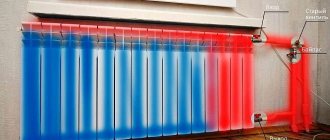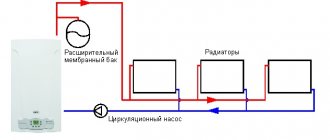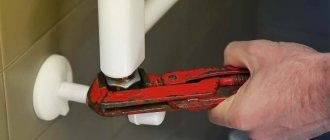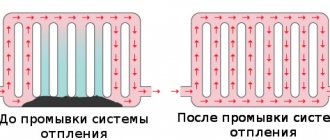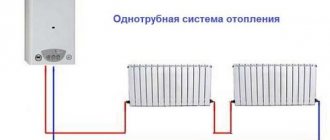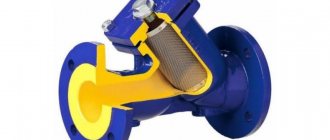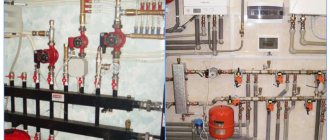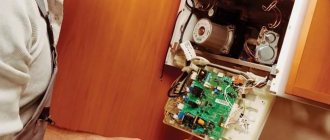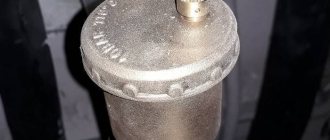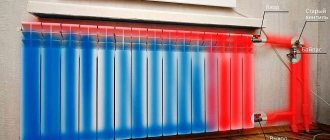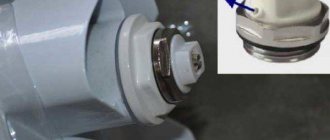The heating system of a house or apartment, consisting of pipes and radiators, is subject to a phenomenon called airing. Air enters the heating system, forming a plug, and water cannot move through the pipes. The result is a decrease in room temperature. Knowing how to act in such a situation will help you avoid problems.
Airing of the system - an air lock formed in the pipe
Filling the system correctly
The easiest way is to pump water or antifreeze into pipelines connected to an open expansion tank.
To do this, you need to open all the valves (except for the drain) and, by connecting the hose to the make-up fitting, fill the lines and radiators with coolant. In this matter, it is important to take your time and allow the air to leave the system on its own through the expansion tank
Advice. After filling, turn on the circulation pump and boiler, and then warm up all heating devices. Then release the remaining air from them through the Mayevsky taps. Do not forget to bleed the pump before starting, as described above.
Now about how to bleed air from the radiators and pipelines of a closed heating system in a private house. The proposed technique is constantly practiced by our expert, plumber Vitaly Dashko. performed in the following order:
- Open all shut-off valves of the main circuits (except for the drain).
- Close all radiator valves, excluding the very last batteries at the ends of the loops, so that circulation occurs through them.
- Get an assistant to do the work. Its task is to be in the boiler room and maintain the pressure in the network at a level of 1 bar using a pressure test pump or through a feed branch from the water supply.
- After opening the water supply, fill the main lines, expansion tank and boiler tank. Air must be released through the safety group valve and air vent at the highest point (if equipped).
- Go to the first radiator from the boiler and open both taps at the same time (slowly). Bleed the air through the Mayevsky valve and close the valves again. The assistant at this time does not allow the pressure to drop below 1 bar.
- Repeat the operation on all batteries, then turn on the circulation pump and start the heat generator. When the lines begin to warm up, open all the radiator valves one by one and remove any remaining air from them again.
Important point. Before squeezing air plugs out of radiators, be sure to bleed the air from the circulation pump and turn it on for 5-10 minutes to bleed the pipelines.
After the heating devices have completely warmed up, the pressure in the system should be in the range of 1.3-1.6 Bar. At this point the procedure is considered complete. If the system contains heated floors, then they should be filled last, using the same algorithm (on cold floors!). That is, having pumped up the pressure in the main line, you need to alternately open and close the floor circuits, bleeding air through the manifold valves, and then warm up and adjust the coolant flow.
Note regarding the installation of automatic air release valves. Such a device should always be in the boiler safety group, and the second, third, and so on - only when the lines pass above the radiators. With lower wiring in a one-story house, air accumulates in the radiators, since they are located above the pipelines, and it is not necessary to install valves on them.
Features of automatic air vents
In order to bleed air in closed heating systems, such as underfloor heating in a house, human intervention is not required.
High performance does not reduce the strong sensitivity to impurities in the coolant, so they are installed together with filters. Filters are installed both on the supply line and on the return line. In order to remove air most effectively, their design has stages, which makes it possible to remove oxygen from each group of devices.
If the pipes were installed in a private house at a slight angle in the direction of water flow, the drain mechanism allows the heating to be ventilated with a large flow of coolant and increases the pressure.
How to remove air or aluminum unit
First you need to determine that the problem really exists. Its presence is indicated by the absence of heating of ½ of the radiator. The air is in the colder half.
Aluminum battery
The instructions are:
- Close the shut-off valve (upper). The bottom one should be left open.
- Place any container near the spout.
- Open the tap.
- Wait for the water to drain out. It must be clean. There should be no air impurities in it.
- Take 1000-3000 ml of water.
Perhaps after this the remaining air, if there is any, will come out. You need to wait 10-15 minutes, after which the tap can be turned on.
Then you need to open the tap on the battery.
New filling of a closed system
A feature of closed systems is the absence of direct contact with the atmosphere. The air in such systems must be manually released through bleeder valves.
The taps in such a system are located at several points : at the top point of the system above the boiler or on the top floor, in the boiler itself, on the radiators.
When filling, a transparent hose is placed on the top tap, and the coolant is pumped until clean water comes out of the hose.
The tap is closed, air is pumped into the membrane expansion tank to create pressure and the batteries are de-aired.
When a circulation pump , it will successfully drive away the remaining air. If after some time gurgling sounds are heard in the boiler or radiators, it is worth repeating the operations with the taps.
Heating system without air locks
To ensure that air in an individual heating system does not accumulate in problem areas, but goes outside, it is necessary:
- correctly design and install the pipeline, correctly install radiators;
- use automatic and manual air vents.
Let's look at how to expel air from a heating system with natural circulation and top wiring
When arranging a pipeline, it is important to maintain an inclination angle at which air bubbles move freely upward, to the highest point of the circuit, without accumulating at turns and flat areas. At the highest point of such a system, an open-type expansion tank must be installed, through which air bubbles enter the atmosphere
Bleeding air from the heating system using an automatic air vent
To bleed air from a system with forced movement of coolant or a gravity system with bottom wiring, a different principle is used
. Return pipelines are installed at a slope (this simplifies draining liquid from the system), and at the top point of all individual circuits, automatic valves are installed through which air is discharged as it accumulates.
In addition to automatic air vents, the system also uses manual Mayevsky valves. Such air vents are mounted on heating radiators - on the upper pipe on the opposite side of the pipe supplying the heated coolant. To ensure that air enters the valve and does not accumulate in the upper radiator manifold, it is recommended to install the heating device at a slight angle. Air release is performed manually as needed.
How to find an air lock?
Ideally, the system independently copes with airing thanks to automatic valves through which air is released. If you discover that a particular heating device or part of the circuit is not working properly, you need to find the place where the air has accumulated.
Touch the radiator - if its upper part is colder than the lower part, it means that coolant is not flowing there
. To release air, open the Mayevsky valve installed on a steel, aluminum or bimetallic radiator, or the valve valve mounted on cast iron batteries.
How to determine an air lock in a battery
You can also determine the place of airing by sound - under normal conditions, the coolant moves almost silently, extraneous gurgling and sounds of overflow occur due to an obstacle in the flow
.
Metal pipes and heating appliances are tapped with light blows - in places where air accumulates, the sound is noticeably louder.
Getting rid of the airlock
If there are manual air vents on radiators, there are no problems with how to remove air from the batteries. Using a screwdriver or a standard wrench, the stem of the Mayevsky tap is slightly unscrewed, and a suitable container is placed under the drain hole (a half-liter glass jar is enough). Bleeding air from the heating system using a manual air vent is accompanied by hissing and whistling, then splashes appear, after which the coolant begins to flow in a thin stream. At this stage, the Mayevsky tap should be closed.
Note! If the battery continues to heat poorly after de-airing, the problem may lie in a blockage. In this case, the heating device is dismantled and washed
After reinstalling the radiator, check the system for air pockets.
To remove an air lock from the heating system if it has accumulated away from the air vent (manual or automatic), proceed as follows
:
- Open the air tap or valve closest to the air bubble.
- They begin to gradually replenish the system with coolant so that the liquid, due to an increase in volume, displaces the air bubble towards the open air vent.
Automatic vent valve with corner connection
What to do in difficult cases when the plug is not removed by adding more coolant? In such a situation, in addition to increasing the amount of coolant, it is necessary to add pressure, heating the liquid to critical temperatures. You should act extremely carefully so as not to be scalded by the splashes that accompany the release of air through the automatic valve.
Important! If a plug is systematically formed in the same section of the pipeline, cut a tee in this place and install an automatic valve
Reasons for reduced efficiency of heating radiators
Old radiator
There may be several reasons for this. The first and probably the most common is the formation of an air lock. How and why it is formed is another question. But one thing is clear: the presence of such a plug in the pipeline or heating radiator slows down the progress of the coolant or stops it altogether.
The second reason for cooling the heating radiator is the presence of debris in the pipes and radiator, that is, scale and large particles. They move along with the coolant through the heating system. The practice of operating heating systems shows that a narrowing of the internal diameter by 1 - 2 mm, due to the formation of scale on the walls, leads to a decrease in the thermal output of the heating battery by 15%, or even more. That is why before the start of the heating season it is necessary to clean the heating radiator in the house.
Bleeding air without a Mayevsky crane
Most home heating radiators have a special device that helps simplify the task of bleeding air as much as possible - a Mayevsky tap or an automatic valve.
But the question is: what to do if there is simply no such device on the battery? If this is exactly the picture that appears before your eyes, most likely, cast iron batteries are installed in your house. Such batteries are often fitted with a simple plug, which is screwed onto a tow coated with paint. In addition, it was also covered with a layer of paint while painting the heating radiators.
Mayevsky crane
It seems difficult to remove it in order to gain access to the coolant located in the system. For this reason, the simplest way out of the situation is to contact your neighbors from the top floor of the house (they will probably have a Mayevsky tap on the radiator). But if the neighbors, for example, have left or you yourself are a resident of the top floor and there is no tap? In this case, you will have to resort to the “old-fashioned” method of bleeding air from the heating system.
So, you need to stock up on a basin, a bucket and plenty of rags. In addition (you can’t take this “barrier” with your bare hands), you will need an adjustable wrench to unscrew the plug and some kind of paint solvent. Otherwise, you simply will not be able to move the plug from the “dead” point.
So, first apply solvent to the place where the plug is installed and wait about 15 minutes. After this, carefully start moving the adjustable wrench along the thread until the plug begins to feed. You will hear the air begin to bleed. When the sound subsides (a sign of lack of air), be sure to wrap a layer of foam around the plug and insert it into place. If desired, you can lightly paint over the junction of the plug and the battery.
Advice. Before starting work, it is advisable to shut off the riser for work safety, otherwise with a sufficiently sharp jerk you will completely unscrew the plug and the water from the battery will no longer be stopped.
You learned how quickly and quite simply you can cope with the task of bleeding air from a heating radiator in the absence of a Mayevsky tap. Good luck!
Preventive measures
As most people agree, it is still easier to prevent a disease than to treat the consequences it causes. Likewise, with batteries, in order not to be left without heat in cold weather, you need to promptly carry out technical measures to maintain heating radiators, and also install additional devices during installation that will help prevent the formation of blockages and air locks.
For example, Sira heating radiators have a built-in multifunctional deaeration system. During its use, special devices for bleeding air from the system are cut into several places, which allows air to be released separately for each group of heating devices.
In order not to rack your brains about how to blow through an aluminum heating radiator, you just need to promptly install a special device on it - an air vent. There are two types of these devices:
The air vents are manual - they are usually installed on the end side of the battery. They are easy to use to bleed air from the heating system. It is enough to turn the bolt with a special key or screwdriver and the air will begin to escape. Given their low performance, such devices are installed only for home use.
Automatic air vents operate completely autonomously. There is no need to bleed air by unscrewing or opening anything, the device does everything themselves. They can be installed vertically or horizontally.
True, such air vents have one significant drawback: they are sensitive to various types of pollution. Therefore, an additional filter will have to be installed in the system to clean strong mechanical contaminants.
When installing Arbonia heating batteries, installing a full set of additional components allows you to free yourself from constant monitoring of the heating system.
For cast iron radiators, you can also install special air vents; this is most important for apartments in multi-storey buildings. In fact, it is much simpler and easier than having to deal with blowing or washing batteries later. In any case, the first option to return heat to the battery is simpler, but if the battery is clogged, nothing other than flushing will help.
In order to flush cast iron radiators, you will first have to completely disassemble the battery using a blowtorch to unscrew the connecting nuts. Then the radiator is disassembled into sections, the nipples (threaded connections between the battery sections) are cleaned, and washed using a hose. All this requires incredible strength, because the weight of each section of a cast iron radiator can reach up to 7 kilograms.
In order to prevent blockages in cast iron batteries, special jumpers must be installed, in which all the dirt settles. In high-rise apartments, the presence of jumpers is simply mandatory. Indeed, often at the beginning of the heating season, the water entering the heating system is, to put it mildly, completely unclean.
After a long period of inactivity, all dirt and rust, as a rule, rush into the heating elements with the first flow of hot water. Needless to say, but, unfortunately, our Russian central heating systems are extremely imperfect.
Helpful advice. If an air lock has formed in your heating system, try to find out the cause of its occurrence, especially if this has not happened before. Try not only to get rid of the air, but also to take measures to prevent a recurrence of this situation. Check the system for leaks at the junctions of pipes and radiators. Perhaps somewhere you need to tighten the bolts, or change the nuts, you may need to re-seal the joints using more tow.
The quality of the heating system depends on how prepared it is for the season. Before the onset of cold weather, it is necessary to check all heating devices included in the utility network and, if necessary, correct all problems.
It often happens that at the beginning of the heating season, normal-looking radiators stop efficiently warming up the room. There are several reasons for this, and therefore in this article we will look at what problems may arise, how to vent the heating battery or how to clean it.
Carrying out repair work
If you discover signs of air in the heating system, you should not immediately start getting rid of it. First, check the circuit for integrity and tightness. After all, if there are leaks, problems will continue.
Coolant leak
Coolant leakage is the loss of fluid that occurs due to loose connections and damage to the circuit.
Photo 1. Leak in the heating system pipe. Such a problem can cause poor operation of the heating structure.
Possible leak locations and solutions:
- Pipe sections. To stop the leak, clamps and cold welding are used. If the pipe is plastic, the entire section is replaced.
- The joints between parts of the system are sealed. Welding is used.
- Loose connection of radiator sections. You will have to remove the battery and tighten the connections (on aluminum). Cast iron radiators are glued with a cloth containing epoxy resin.
This is a labor-intensive part of the work of preparing the system for the heating season. But this must be done, otherwise you may be left without heat in winter.
A constant loss of coolant will lead to unstable operation of the system.
Features of the underfloor heating system
The presence of a heated floor complicates the system; it is not easy to remove air from the floor loops.
Air plugs appear due to:
- reducing pressure;
- strong heating of the coolant;
- leakage formation;
- violation of the tightness of connections;
- errors made during installation (uneven surface, pipe slope, errors in the organization of the collector);
- illiterate first launch of the system.
In order for the system to start correctly, the air is bled from it before the boiler is turned on and the coolant is heated.
If a warm floor is the main means of obtaining a comfortable temperature, then air should not be allowed into it.
Attention! A conventional system works even if there is air there. Efficiency will decrease, but heat will still flow
When air appears in the circuit, the floor will stop heating - the reason for this is the complex installation and small diameter of the pipeline.
Removing air from the floor circuit is a lengthy process:
- Only one circuit on the collector is turned on.
- The pressure is built up above the working pressure (15-20%).
- The circulation pump starts at low speed. It takes some time to fill the circuit so that the coolant displaces the air. Then the next circuit is activated, so one by one all the branches passing through the collector are slowly filled.
- The process lasts several days. This is repeated until all the air is released.
- This is done with cold coolant; heating is turned on only when it is certain that the air has completely escaped.
Reference. When installing the system, it is useful to think about equipping the floor circuit with a separator - a device for automatically removing air from the pipes.
Coolant renewal frequency
Liquid is an important component of heating that must be used correctly.
Periodic replacement is necessary, but should not be overused. The optimal shelf life of liquid in pipes is 12 months, subject to mandatory draining of the system.
Synthetic coolants: propylene glycol, ethylene glycol remain in the system for up to 7-8 years.
Photo 2. Canister with synthetic coolant for the heating system. This substance lasts longer than ordinary water.
The concentration of synthetic compounds in the liquid extends the shelf life of the coolant. But if there is no need to use antifreeze, then you can get by with plain water.
The replacement time will be determined by coarse filters: if they do not need to be washed and replaced, then the water in the system is also suitable and does not need to be changed.
This is important because each fresh portion of liquid is a fresh set of salts and impurities, oxygen, which reacts with new forces with internal surfaces, settling on them in layers that gradually reduce the efficiency of the system. Important! The water that is already in the circuit is a prepared liquid, without impurities and active substances
The fact that the water has changed color does not change its value - it has already undergone reactions, has become inert and is now an optimal addition to the efficiency of the system
Important! The water that is already in the circuit is a prepared liquid, without impurities and active substances. The fact that the water has changed color does not change its value - it has already undergone reactions, has become inert and is now an optimal addition to the efficiency of the system
If the radiators are clogged, you can remove them for cleaning without draining them; just turn off the valves.
Deaeration methods
Often, one or more of the above problems are observed in heating systems in an apartment or house. They need to be solved and the air released so that the radiators heat up normally and transfer heat to the rooms. The operation of releasing air from the network can be carried out using different methods. In many ways, the chosen method depends on the type of hot water circulation: forced or natural.
- In a heating system with natural circulation, which is installed at the top of the pipes, unwanted air congestion can be eliminated using an expansion tank. It is located at the highest level compared to the entire network. The supply pipe must be laid with a rise to the expansion tank. If the pipe distribution is lower, the de-airing scheme occurs in the same way as in heating systems that are equipped with a circulation unit.
- If the heating system uses forced circulation, then an air collector is installed at the highest point through which air is discharged. In this mode, the pipeline gradually rises upward in the direction of hot water movement, and air bubbles are released through the air taps. These devices are always mounted at points located at the very top of the network. If repairs are necessary, during which the system is emptied, the return pipeline along its entire length is arranged with a slope that facilitates drainage of water.
Very important information
Below we will describe situations when one or another inclusion of the battery may be undesirable, and sometimes unacceptable!
4.1.You cannot use the thermostat without a jumper
In point 2 we talked about the thermostat. However, you need to understand that experiments with a temperature controller are only possible with a jumper! If it is not there, and you reduce the diameter of the flow pipe, then the total flow of hot water through your apartment will decrease. Which of course is unacceptable, otherwise your neighbors will come to you!
4.2. The thermostat may become clogged
If you are using a jumper, but for some reason it was turned off for a while and the thermostat was set to position 5, i.e. provided a full flow of hot water only through the battery, as shown in the figure:
then everything seems to be fine. However, we must accept reality as it is. Even if we turned on the central heating radiators correctly for the first time, there is no guarantee that, for example, in a month or two a new mud flow will not pass through the pipes. But then, if the jumper is turned off, then the splash of dirt will go straight to your thermostat, which, in fact, is very sensitive to it. As a result, a blockage forms in the thermostat, and water will not flow into the battery at all. It won’t go into the jumper either, because you closed it. Therefore, in this situation, water will stop flowing through your apartment; in the house, through your heating riser, the water will also stop and begin to cool in the cold. As a result, a squad of evil neighbors, together with the chairman of the HOA or housing cooperative, is guaranteed to enter your apartment.
It is clear that switching on according to the above figure is similarly not acceptable for the regulator positions 4,3,2,1,*
4.3. The jumper must always be on
Make it a rule that it doesn’t matter whether you use a temperature controller or not, but the jumper should always be on. Thus, you will always ensure the flow of hot water through your apartment
When does it make sense to turn off the jumper? For example, when you feel that the battery is clogged. Then you let all the water flow through the battery by disconnecting the jumper. Perhaps a more powerful stream of hot water will be able to push through the stuck dirt. But this needs to be done for a short time and only under your control - you cannot leave the situation like this and go to sleep. The fact is that if the dirt cannot be pushed through, then a congestion will form again: water will not be able to pass through either the battery or the jumper.
This is mega important, because if it is installed before the jumper, then when you first turn it on, dirt will definitely clog your thermostat, and you will start the heating season with a complete rewiring of the battery:
Other reasons
It is important! Scale accumulates on the walls of pipes and radiators, which contributes to the wear of heating devices, and also reduces their heat transfer. As experts assure, 1 mm scale reduces heat transfer by 15%. To prevent this from happening, it is necessary to clean the radiators.
Let's look at how to wash radiators, and most importantly, how to do it correctly. If at least one of the reasons listed below is detected, then “treatment” begins.
- The riser is hotter than the radiator;
- The radiators in one room are hotter than in another;
- Your neighbors' radiator is warmer than yours;
- The top of the battery is hot and the bottom is cold;
- Sections do not heat up equally.
If you live in an apartment building and there are cast iron radiators installed in the room, then you need to agree with your neighbors and periodically clean the radiators.
Let's look at the existing methods:
- Hydrodynamic flushing of heating radiators - a mixture (compressed air and water), which is under high pressure, is supplied into the riser using special compressors at certain intervals. As a result, bubbles form in the water, contributing to the chipping and detachment of plaque and scale from the inside of the battery. This is an effective method, but requires certain financial investments. If the batteries are cast iron, then they may stop working properly due to accumulated scale and deposits, which are quite difficult to get rid of by chemically flushing the system. This method is environmentally friendly, but to use it you need to contact specialists and transfer the heating device to a service center, where it will be treated with a special agent that softens deposits. After which the battery is washed, and it takes on its original appearance;
- If neighbors refuse to wash their heating appliances, then you can carry out individual cleaning, which will be cheaper. To do this, remove the radiator and move it to the bathroom. Cover it with rags (so that the enamel does not crack), install a mesh on the drain (so that the sewer does not become clogged), disassemble the mixer, remove the watering can from it and begin rinsing. In order to achieve the effect, periodically turn the heating device. You may need to remove solids using wire or other means. As soon as clean water begins to flow out of the radiator, you can stop the procedure (the battery is washed) and clean it outside in order to give it a neat and aesthetic appearance;
- Let's look at how to clean a heating radiator using soda ash. Hot water is poured into the radiator and soda is added, after an hour they begin to tap the radiator with a wooden hammer, drain the water and repeat the procedure several times (until the heating device is completely cleaned). For this method, you can use whey or a car radiator cleaner;
- Pneumohydropulse washing is carried out with a special pistol, which is convenient and compact. This equipment is used to clean models that have a diameter of up to 15 cm. The gun removes deposits from a distance of 50 m. Just like when chemically cleaning a heating device, it is not dismantled, but the difference is that a pneumatic or water gun can perform spot cleaning.
Features of operation
Let's look at how to use the Mayevsky crane. To do this, it is advisable to place some kind of container under the battery and stock up on a dry cloth. Using a wrench or screwdriver, turn the locking screw counterclockwise a quarter or half a turn. Air will begin to hiss out of the system. When it comes out completely, water will flow from the tap. You must wait until the water starts flowing continuously. After this, the locking screw can be tightened.
Knowing what to do, bleeding air from the radiator is very simple.
If the air was successfully bled out, but the battery remained cold, then this is a sign of clogging. To clean a clogged battery, you will have to resort to the help of plumbers.
If the tap hole is clogged, it can be cleaned with a needle or other sharp object.
If the faucet has not been used for a long time, the rotation of the adjusting screw may be difficult due to the formation of corrosion on it. If this situation occurs, use WD-40 lubricant spray. Within a few minutes after applying it to the screw thread, it can be easily unscrewed. At the end of the heating season, it is advisable to lubricate the adjusting screw with silicone grease. In this case, the thread will not be destroyed by the influence of the coolant on it.
If you need to replace the Mayevsky tap, use two adjustable wrenches. Use one key to hold the cap on the radiator, and the other to unscrew the tap. If this is not done, then unscrewing the tap can weaken the plug and lead to loss of its tightness.
We looked at how to bleed air from the system using a Mayevsky valve yourself and how to operate an automatically controlled device. If you provide the necessary care to this device, check it and clean it in a timely manner, the device will serve for a long time without causing any problems to its owners.
The price of a Mayevsky crane depends on its type, material of manufacture, diameter, and starts from 30 rubles.
A centralized or individual heating system needs adjustment. The weather has a pleasant property of changing, but the temperature of the coolant in the system most often remains unchanged. As a result, a sad picture is observed: there is frost outside the window, and tropical heat in the rooms. Owners of private houses with individual heating can fully control the air temperature in each room thanks to modern automation systems.
But there is also a less expensive way to regulate the intensity of coolant flow - installing taps on radiators. The presence of these simple but useful devices also allows for more efficient repair and maintenance of radiators, since with the help of such taps you can disconnect the radiator from the system at any time, and then just as easily connect it again.
Who should bleed the radiators in the apartment?
A little about the legal side of the issue. The answer depends on the legislative acts of a particular state. For example, in the Russian Federation there is a Decree of the State Construction Committee dated September 27, 2003, in accordance with which the situation when there is air in the heating radiators must be corrected by housing and communal services employees. Other CIS countries also have similar legislation.
In practice, housing and communal services personnel long ago assigned this responsibility to residents of the 5th, 9th, 16th and other upper floors. Although, according to reviews from homeowners, in some cities, teams of plumbers, after launching the system, conscientiously check the heating devices in each apartment and remove air locks.
How to bleed air from the boiler
To do this, periodically open and close the Mayevsky tap, with an interval of several minutes. The procedure is repeated until a hiss or whistle appears, indicating the release of the air lock. The appearance of sound requires holding the bleeder in the open position until the coolant appears.
The lack of special devices for removing plugs on the boiler requires the use of the same devices on pipelines located above the heat source.
If there is no circulation pump in the closed circuit that cuts off the boiler with the return pipeline, then turn on the energy source: gas, electricity, and in the case of solid fuel, light the firebox. After heating the “supply” pipeline, the deaerator is periodically opened. The coolant, heating up, will rise from the boiler along the main line due to heating and return through the connecting pipeline - back to the heat exchanger. This technique requires careful monitoring of the temperature, especially when servicing a heat source other than solid fuel. The movement of coolant along such a circuit will be very slow and this is taken into account when performing work.
If it is not possible to shut off the boiler water circuit and there are air vent devices only in the upper part of the line, it is necessary to drain the coolant and then fill in the entire required volume of water. Before embarking on such global measures, it is recommended to turn off all devices (except the boiler) and, turning on the pump, release the pressure through the nearest air vent on the main line until sound or bubbles appear. The absence of a result indicates the need to completely drain the coolant.
Consequences of airy heating
If the plug is not removed in time, prolonged contact with oxygen will negatively affect the metal, and it may become covered with scale and begin to deteriorate. In addition, the airiness of the system affects the circulation of water, as a result of which some places overheat and others are poorly heated.
There are various methods for bleeding gas, and priority should be given to one or the other depending on the choice of coolant. And also, on the method of water circulation in the system: natural or forced.
As a result, an air valve is used to allow the air plug to be released from the radiator or a Mayevsky valve.
How to remove an air lock in the engine cooling system
Before moving on to the process of removing air locks from the cooling system, let's start with the main reasons why they appear.
- First of all, it is worth mentioning depressurization as a result of broken connections of tubes, hoses and pipes. All this leads to the system sucking air through leaks at the joints. Air plugs also form when antifreeze/antifreeze is added.
- It is also worth highlighting malfunctions in the operation of the air valve. As you know, when heated, the antifreeze in the system expands and the pressure increases, but when it cools, the valve is responsible for equalizing the pressure. If the pressure is low, the valve allows air from outside. If there is a problem with this valve, excess air accumulates in the system.
- Sometimes the pump seals stop sealing the system, which leads to air leaks. Also, antifreeze can leak, its volume naturally decreases and excess air accumulates.
So, having dealt with the reasons, let’s move on to the consequences and signs that the cooling system is airy. Let us note right away that the consequences can be quite serious. An air lock can disrupt the circulation of antifreeze, especially if the air does not allow coolant to pass into the radiator. As a result, the motor overheats.
Also, the heater in the cabin begins to work poorly, which reduces comfort when using the vehicle in winter and can pose a threat to the health of the driver and passengers. To solve the problem, you need to know how to remove air from the engine cooling system. At the initial stage, you should make sure that the antifreeze level is normal, and that the cooling system itself is sealed, that is, there are no leaks.
To do this, you need to inspect all rubber parts, hoses, pipes, fittings, etc., and with the engine running. Detection of a leak will require immediate repair. If there are no leaks, but the engine overheats or, conversely, remains cold for a long time, you need to check the thermostat.
It often happens that the device jams in the open or closed position (coolant circulates only in a small or large circle). Less commonly, the reason is that an air lock has formed in the thermostat area.
Problem Definition
To identify air pockets in heating you need:
- try to touch the batteries, and if part of the surface is cold or barely warm, this will mean there is air in the system;
- if the temperature in the room drops for no reason;
- if gurgling is heard in the radiator.
It is very easy to check whether the system needs bleeding by tapping a metal object on the top of the battery, and then doing the same at the bottom. Where the traffic jam occurs, the sound will be louder.
